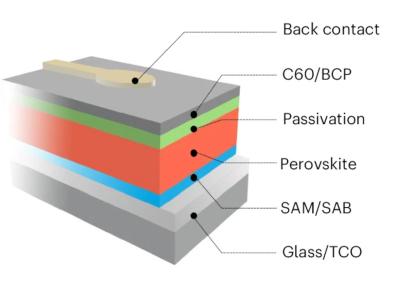Researchers from China's Xi’an Jiaotong University, Huazhong University of Science and Technology, Fudan University, ULVAC-PHI Instruments, National University of Singapore (NUS), Sweden's Uppsala University and EPFL have developed a self-assembled bilayer (SAB) that can be used as a hole contact material that grants improved adhesive contact with the perovskite film.
A schematic illustration of the inverted PSCs. Image from: Nature Energy
The team went on to fabricate an inverted perovskite solar cell that utilizes the self-assembled bilayer (SAB) as a hole-selective molecular contact. The cell was made with a substrate made of glass and transparent conductive oxides (TCOs), the proposed bilayer, the perovskite absorber, an ETL based on buckminsterfullerene (C60), a bathocuproine (BCP) buffer layer, and a silver (Ag) metal contact.
The scientists reported power conversion efficiencies exceeding 26% for the inverted PSC, an open-circuit voltage of 1.185 V, a short-circuit current density of 26.27 mA cm2, and a fill factor of 83.84%. The cell was also able to retain around 94% of its initial efficiency after 2,000 h of damp heat testing at 85 C. The champion devices demonstrated less than 4% and 3% efficiency loss after 2,000 h damp heat exposure (85 °C and 85% relative humidity) and over 1,200 thermal cycles between −40 °C and 85 °C, respectively, meeting the temperature stability criteria outlined in the International Electrotechnical Commission 61215:2021 standards.
The proposed SAB consists of a phosphonic acid self-assembled monolayer (SAM) with an upper layer made of an organic compound known as triphenylamine, which is intended to improve the adhesive contact with the perovskite film compared with a conventional SAM-perovskite interface. It also enhances the interface's thermal and mechanical robustness.
“SABs represent a basic form of self-assembled multilayers, consisting of distinct monolayers with varying constituents—interconnected via covalent or ionic bonds,” the researchers explained. “This layer-by-layer assembly stabilizes the labile monolayer by introducing rigid components and enables control over film termination.”
“Notably, the best SAB device demonstrated a relative efficiency loss of less than 4% over 2,000 h, which is in line with the industry benchmark of a 5% loss over 1,000 h for silicon photovoltaics,” the scientists said, noting that the result, which was certified by the China National Accreditation Service, is among the most efficient inverted perovskite devices ever built to date.




